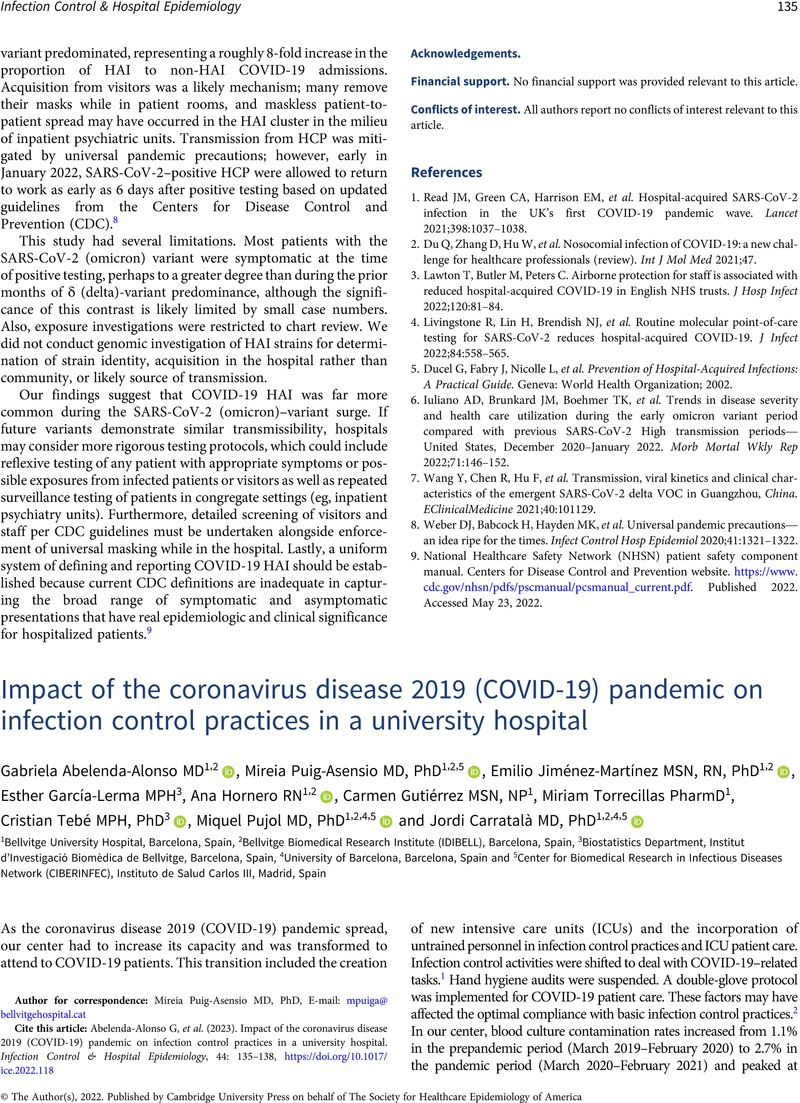Crossref Citations
This article has been cited by the following publications. This list is generated based on data provided by Crossref.
Trevijano-Contador, Nuria
Torres-Cano, Alba
Carballo-González, Cristina
Puig-Asensio, Mireia
Martín-Gómez, María Teresa
Jiménez-Martínez, Emilio
Romero, Daniel
Nuvials, Francesc Xavier
Olmos-Arenas, Roberto
Moretó-Castellsagué, María Clara
Fernández-Delgado, Lucía
Rodríguez-Sevilla, Graciela
Aguilar-Sánchez, María-Mercedes
Ayats-Ardite, Josefina
Ardanuy-Tisaire, Carmen
Sanchez-Romero, Isabel
Muñoz-Algarra, María
Merino-Amador, Paloma
González-Romo, Fernando
Megías-Lobón, Gregoria
García-Campos, Jose Angel
Mantecón-Vallejo, María Ángeles
Alcoceba, Eva
Escribano, Pilar
Guinea, Jesús
Durán-Valle, Maria Teresa
Fraile-Torres, Arturo Manuel
Roiz-Mesones, María Pía
Lara-Plaza, Isabel
de Ayala, Ana Pérez
Simón-Sacristán, María
Collazos-Blanco, Ana
Nebreda-Mayoral, Teresa
March-Roselló, Gabriel
Alcázar-Fuoli, Laura
and
Zaragoza, Oscar
2022.
Global Emergence of Resistance to Fluconazole and Voriconazole in Candida parapsilosis in Tertiary Hospitals in Spain During the COVID-19 Pandemic.
Open Forum Infectious Diseases,
Vol. 9,
Issue. 11,
Park, Jae Hyeon
Kim, Taek Soo
Lee, Chan Mi
Kang, Chang Kyung
Park, Wan Beom
Kim, Nam Joong
Choe, Pyoeng Gyun
and
Oh, Myoung-don
2023.
Effect of Wearing Personal Protective Equipment (PPE) for COVID-19 Treatment on Blood Culture Contamination: Implication for Optimal PPE Strategies.
Journal of Korean Medical Science,
Vol. 38,
Issue. 23,
Alsaffar, Manar Jaffer
Alsheddi, Faisal Mohammed
Humayun, Tabish
Aldalbehi, Fayez Zabar
Alshammari, Wafa Hamad Sayah
Aldecoa, Yvonne Suzette
Burhan, Nadeen Mahmoud
El-Saed, Aiman
Tawfeeq, Sameh
and
Alanazi, Khalid Hamdan
2023.
Impact of COVID-19 pandemic on the rates of central line...associated bloodstream infection and catheter-associated urinary tract infection in an.ßintensive care setting:.ßNational experience.
American Journal of Infection Control,
Vol. 51,
Issue. 10,
p.
1108.
Hlinkova, Sona
Moraucikova, Eva
Lesnakova, Anna
Strzelecka, Agnieszka
and
Littva, Vladimir
2023.
Central Line Associated Bloodstream Infections in Critical Ill Patients during and before the COVID-19 Pandemic.
Healthcare,
Vol. 11,
Issue. 17,
p.
2415.
Durà-Miralles, Xavier
Abelenda-Alonso, Gabriela
Bergas, Alba
Laporte-Amargós, Júlia
Sastre-Escolà, Enric
Padullés, Ariadna
Carratalà, Jordi
and
Gudiol, Carlota
2024.
An Ocean between the Waves: Trends in Antimicrobial Consumption in Hospitalized Patients with COVID-19.
Antibiotics,
Vol. 13,
Issue. 1,
p.
55.




